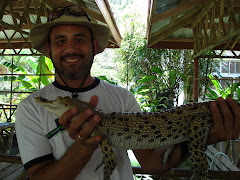
This latest disaster involving the ship, Princess of the Stars brings to mind my own recent trip to Sibuyan Island. The ship sank just 200 meters from the shoreline of San Fernando, one of the towns in Sibuyan I visited last April. One of the first reports of casualties was issued by Mayor Tansinco, who had graciously hosted breakfast for us back then. Her desperate call for help for her typhoon ravaged town came out in the papers today. My heart goes out to her and her hospitable town that sits at the foot of the Guiting-guiting mountain range.
Sibuyan is an amazing island that's been isolated from the rest of the Philippines since before the ice age. Hence its flora and fauna has been unique and very diverse. Luckily much of the forests surrounding the mountains are still intact. WWF has been working in Sibuyan for more than 10 years and I believe this is one of the reasons why many of the people there are quite conscious of their environment and are very passionate about keeping their forests intact.
I also recall vividly the inter-island ferry that brought me to the island. The weather was much calmer back in April but even then I would shudder to think how it would be like to be on board a sinking ship. With almost all decks of the ship full of people, it's no wonder scores of people die when ships like these sink. The ship I was in
 wasn't as big as the Princess of the Stars (capacity: 2,000) but still we must have been close to 1,000 given the way they were packing people in. There seemed to be more people than bunk beds. With ships like these, you basically had 3 choices. First class cabin, first class bunks, and what they call COB, cot on board. Most passengers though call it Carton o Banig... and for good reason. People grab any open space on the decks and simply lay down their mats and carton sheets to sleep on. As soon as they're on board many of the passengers won't even leave their spot lest somebody comes along and steals their space.
wasn't as big as the Princess of the Stars (capacity: 2,000) but still we must have been close to 1,000 given the way they were packing people in. There seemed to be more people than bunk beds. With ships like these, you basically had 3 choices. First class cabin, first class bunks, and what they call COB, cot on board. Most passengers though call it Carton o Banig... and for good reason. People grab any open space on the decks and simply lay down their mats and carton sheets to sleep on. As soon as they're on board many of the passengers won't even leave their spot lest somebody comes along and steals their space.We thought we were lucky to get the last few bunks at the "first class" section. After going down 2 decks below, I realized it was going to be a long night. The A/C was blowing vast amounts of tepid air into this dark room full of bunks which reminded me of a dungeon. I situated myself away from the draft and took a mental note of where the exit was before forcing myself to sleep. No such luck though and to make matters worse, at the wee ho
 urs of the morning, more passengers started to noisily stream into our deck. Apparently our ship stops at 2 other Romblon towns to pick up passengers.
urs of the morning, more passengers started to noisily stream into our deck. Apparently our ship stops at 2 other Romblon towns to pick up passengers.The ship, like most interisland ships in the Philippines, was probably more than 10 years old. Possibly an old discard from either Japan or Taiwan bought cheaply and refurbished by enterprising Pinoys.
When early morning came I recall seeing the silhouette of Sibuyan Island with the 2,000 meter peak of Mt. Guiting-guiting hidden by the clouds. The memories of a sleepless night slowly faded away as the rising sun began to illuminate the island. There were so many kids on board and their playful laughter and excited talk filled the ship.
It's hard to imagine that almost everyday, these scene is replicated as thousands of Filipinos travel to and fro the islands of this archipelago. Sometimes I think about how to make travel like this safer. There seemed to be enough lifejackets and lifeboats on board yet when ships like these sink, more often than not, over half the passengers perish. In the case of the Princess of the Stars, it's not even a 10 percent survival rate. Experts say that many people simply freeze in terror when placed in a life threatening situation. Could this have been why hundreds died in the Princess? Many of the passengers apparently had time to put on their lifejackets. Yet when faced with the seemingly simple choice between jumping into the sea and staying inside a sinking ship, many chose the latter. Part of this I think is because many (or is it most?) Pinoys don't know how to swim. I've tried to teach adults how to swim in the past and seeing the sheer terror in their faces is a sight I won't soon forget.
The same experts believe the key to breaking this lethargic reaction to crisis is training and drills. So these fire and earthquake drills really do make a difference. A simple act of reading and internalizing those safety cards on the plane can save lives. So the next time you hear, "slip vest around your neck, slip tape around waist and hook into d-ring, pull string to inflate..." listen carefully!






No comments:
Post a Comment